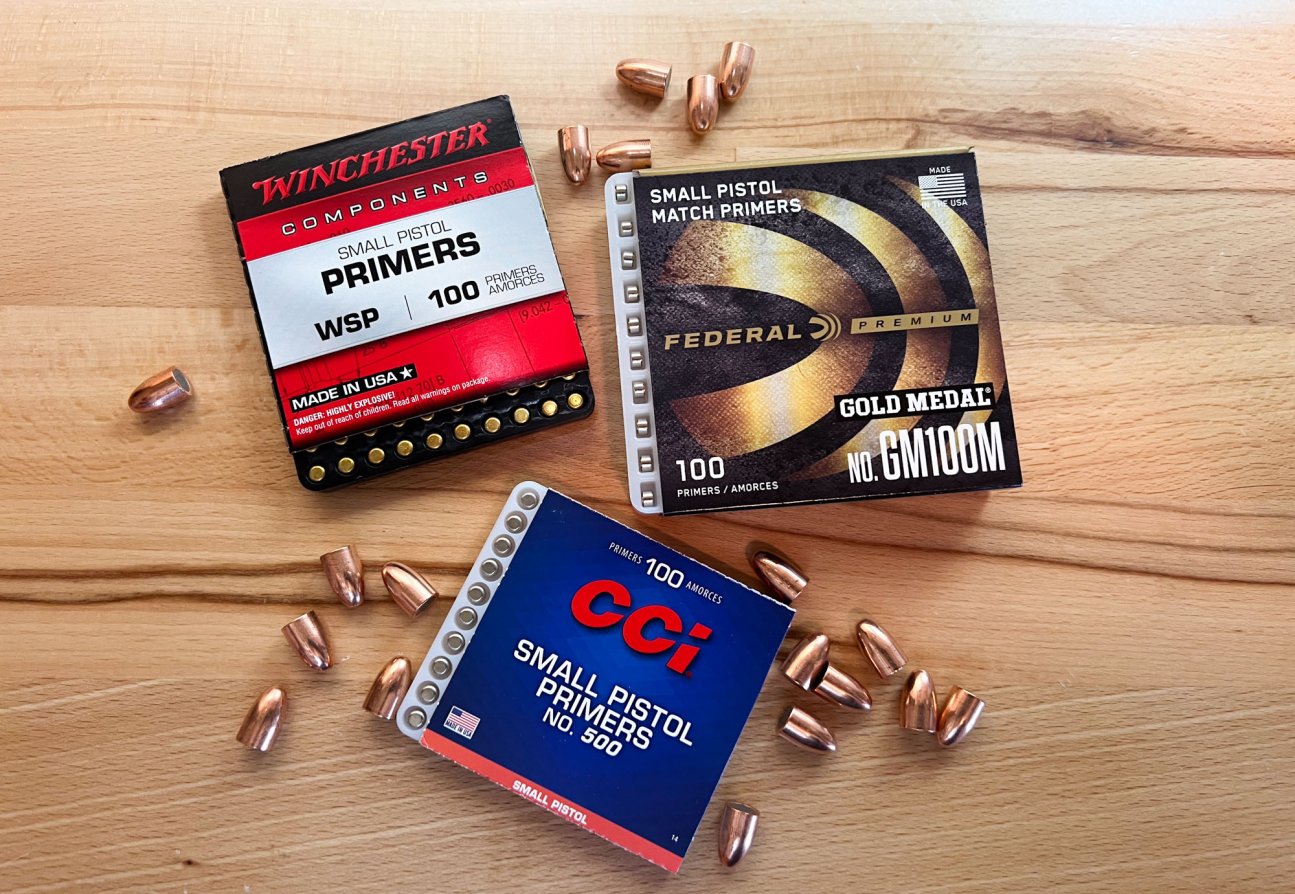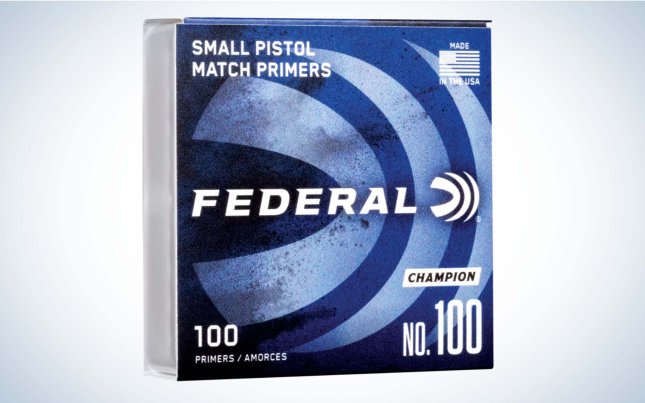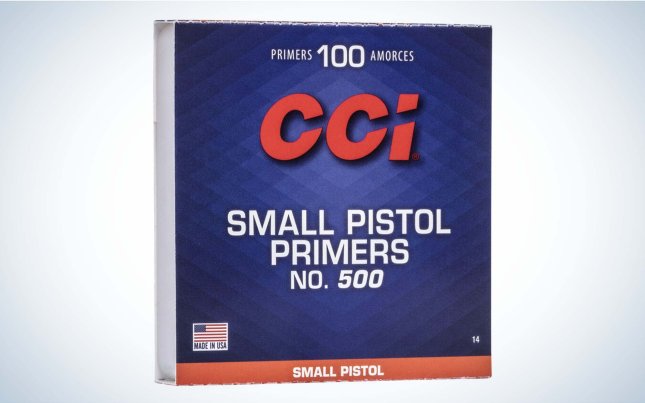We may earn revenue from the products available on this page and participate in affiliate programs. Learn More ›
When it comes to picking the best primer for reloading 9mm ammo the choices are not complicated. Cartridges chambered in 9mm Luger, also known as 9x19mm, and 9mm Parabellum all use small pistol primers.
The Best 9mm Primers for Reloading
To cut to the chase, any of these primers will work great for reloading 9mm cartridges. The differences between them are relatively minor, with price and availability being the deciding factors for most reloaders.
Fortunately, the supply of small pistol primers is good right now and getting better. The crunch we experienced during the Covid pandemic has eased and primers are now readily available online and in stores around the country.
- Winchester WSP
- Federal No. 100 Small Pistol Primer
- CCI No. 500 Small Pistol Primer
- Federal GM100M Small Pistol Match Primer
- Remington No. 1 ½ Small Pistol Primer
- Fiocchi Small Pistol Primers
- Aguila Small Pistol Primers No. 1 1/2

What is a Primer?
A loaded cartridge consists of four things: the brass, the bullet, the powder, and the primer. Primers come in various sizes and compositions for different applications but all perform the same function, which is to ignite the propellant, in turn creating the gasses that force the bullet down the barrel and out of the muzzle.
The primer itself is a self-contained cup that is inserted into the base of the brass and is what the firing pin or hammer strikes after the trigger is pulled. While the chemical makeup of primers vary (Federal’s new lead-free Catalyst primer, which isn’t offered as a component for reloaders yet, is the biggest news on that front), the physical construction of them is identical. They consist of a cup, an anvil, and the igniter compound, which is sandwiched between the two.
Read Next: Best 9mm Ammo
How a Primer Works

When the primer cup is struck, the igniter compound gets pinched between it and the anvil. This causes the compound to ignite and send a jet of flame and hot slag through the flash hole in the case and into the propellant.
Different Types of Primers
Primers for centerfire cartridges come in two physical sizes, large and small. Large primers have a diameter of .210 inches while small primers have a diameter of .175 inches. Primers can be further divided into those meant for rifles and those meant for pistols. So, broadly speaking, there are four types of primers: large rifle, large pistol, small rifle, and small pistol. As mentioned, 9mm handgun cartridges use small pistol primers.

Rifle Primers Versus Pistol Primers
Rifle primers have to deliver more energy than pistol primers since centerfire rifle rounds contain more powder than pistol rounds. So not only are rifle primers more potent in terms of their compound, but rifle primer cups need to be thicker to handle the greater pressures generated.
In contrast, pistol primers have thinner cups, a less powerful igniter compound, and require less energy to set off.
Various Flavors of Primers
Within each of the four broad categories of primers there exist variations for different types of cartridges. The most common variants are standard primers, magnum primers, and match/benchrest primers.
Magnum primers have more oomph than standard primers to reliably ignite the greater amount of powder contained in a magnum cartridge. Benchrest and match primers are manufactured to more exacting tolerances than standard primers, which is why they cost more.
Read Next: Best 9mm Pistols
How Much Do 9mm Primers for Reloading Cost?
You can expect to pay $.08 to $.11 per primer. Generally, off-brand, imported primers cost less. For instance, I’ve recently seen Aguila No. 1 1/2s offered for $80 per 1,000 ($.08 per primer). From the same retailer, Remington No. 1 1/2s were $89 per 1,000, CCI No. 500s were $95 per 1,000, Winchester WSPs were $100 per 1,000, and Federal No. 100s were $105 per 1,000. At the time of publication, all these primers were in stock.
This price spread is typical. Guys will argue concerning the merits of one brand versus another, but many reloaders are looking for one thing only—a button that will go bang when a striker or hammer whacks it.
Can You Reload 9mm Handgun Rounds With Magnum Primers?

Some reloaders will use magnum primers when reloading 9mm rounds. I don’t recommend the practice. Handgun rounds are finicky when it comes to their internal ballistics and it doesn’t take much for a reload to go from safe to dangerous. (This is particularly the case with respect to cartridge overall length. Seating a 9mm bullet deeper than recommended can cause pressures to skyrocket.)
Magnum primers contain more compound than standard primers and will boost pressures accordingly. If you are going to use a magnum primer, make sure to back your powder charge off by 10 percent or so and see what velocities that produces.
Here are some of the common magnum pistol primers on the market:
- CCI No. 550 Magnum Small Pistol Primers
- Federal No. 200 Small Pistol Magnum
- Winchester Small Pistol Magnum Primers
- Remington No. 5 ½ Small Pistol Magnum Primers
- Federal GM200M Small Pistol Magnum Match

Differences Among Small Pistol Primers
Any of the primers listed at the top of the article will work fine for reloading 9mm cartridges. But they aren’t all created exactly equal.
CCI primers, for instance, generate less energy than Federal primers. So a CCI No. 550 Magnum is about equivalent to a Federal No. 100 primer. CCI primers are also considered to be harder than Federal primers, while Winchester primers fall somewhere between the two.
From a practical standpoint the differences are not of any consequence when loading 9mm handgun ammo.
Final Thoughts on the Best 9mm Primer For Reloading
When it comes right down to it there’s no wrong answer regarding which small pistol primer to use when reloading 9mm ammunition. You might see some differences in terms of the amount of fouling generated. And for handguns that don’t have a robust firing pin strike you might be better served with a softer primer, like the Federals.
But for general reloading of range ammo, any of these primers will get the job done.



